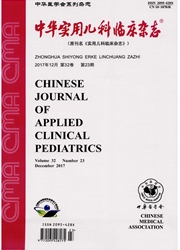

 中文摘要:
中文摘要:
目的分析常染色体显性遗传夜间发作性癫癎(ADNFLE)患者CHRNA4基因序列的变异性,探讨其与ADNFLE发病的关系。方法收集临床诊断为ADNFLE的主要来源于广东和广西的6个家系,其总成员66例,发病24例,同时收集健康志愿者200例作为健康对照。提取二基因组中DNA并特异性扩增CHRNA4的1~6号外显子片段,对其进行纯化与测序。对测序结果进行序列对比分析。采用SPSS13.0软件进行统计学分析。结果在CHRNA4基因第5号外显子中发现4个碱基替换.c.909T〉G、c.1440G〉T、c.1458T〉C及c.942C〉T,均为同义替换。前3种替换属纯合变异,在24例ADNFLE患者和200例健康对照者中均存在,发生率为100%,而942C〉T替换仅出现在1例患者中,属杂合变异。结论ADNFLE患者CHRNA4基因1—6号外显子片段中均未发现已报道的热点突变。CHRNA4基因是否参与ADNFLE的发病,需进一步扩大样本量和进行功能学的研究。
 英文摘要:
英文摘要:
Objective To investigate the virulence gene and mutation features in the Chinese patients with auto- somal dominant noctumal frontal lobe epilepsy(ADNFLE) by using the direct sequencing(DS) PCR products with all the exons of CHRNA4 in 6 ADNFLE families, and to interpret the molecular pathogenesis in Chinese patients affected by ADNFLE. Methods Six ADNFLE families were collected,included 66 people and 24 patients with ADNFLE,and 200 healthy volunteers were selected as control group. The genomic DNA was extracted. The exons 1 -6 in CHRNA4 were am- plified by the PCR. The amplified products were sequenced and analyzed. All data were analyzed with SPSS 13.0 soft- ware. Results There were 4 base substitutions in exon 5, and they were c. 909T 〉 G, c. 1440G 〉 T, c. 1458T 〉 C and c. 942C 〉 T. All those base substitutions were synonymous. The first three were homozygosis substitutions,but the last one was heterozygosis substitutions. Condusions The hot spot mutations of CHRNA4 which have been reported were not de- teeted. Whether or not there is a correlation between ADNFLE and this substitution need to be identified by study with
 同期刊论文项目
同期刊论文项目
 同项目期刊论文
同项目期刊论文
 期刊信息
期刊信息
